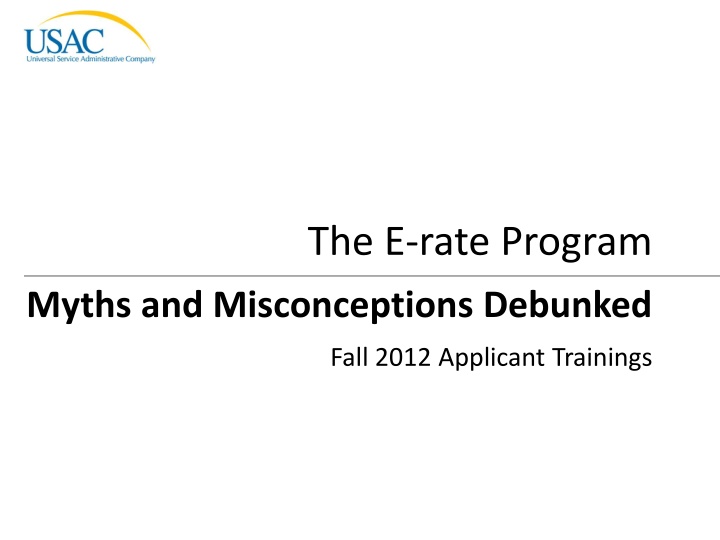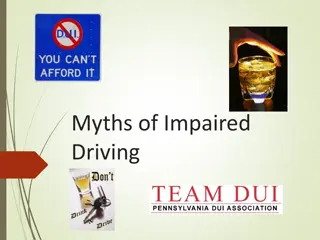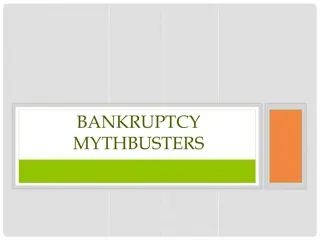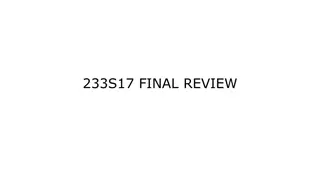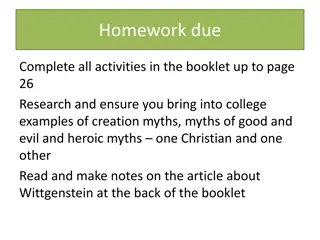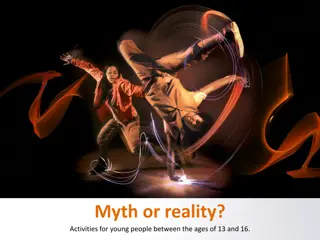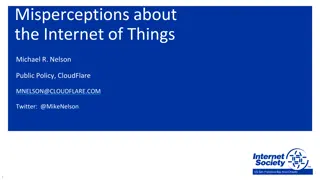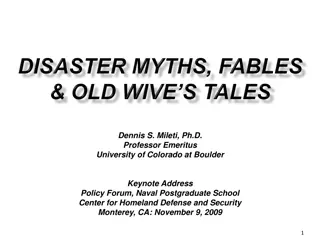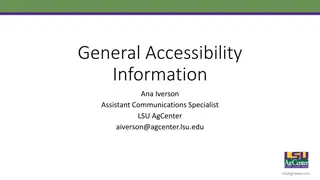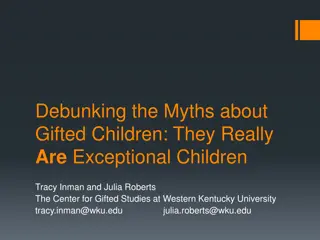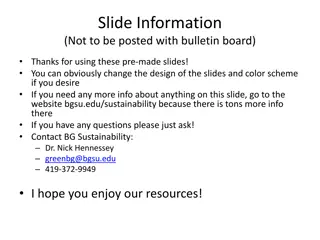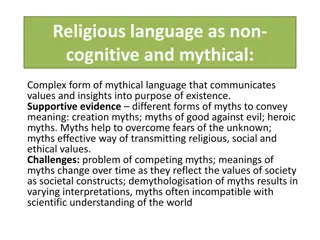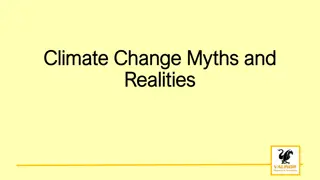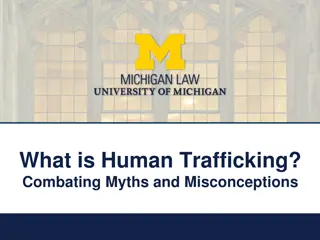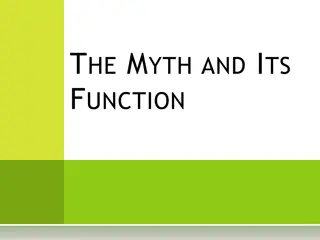Debunking E-rate Program Myths and Misconceptions
In Fall 2012, the Schools and Libraries Fall Applicant Trainings aimed to dispel common myths around the E-rate Program. Topics covered include technology planning misconceptions, eligible services myths, FCC forms misunderstandings, competitive bidding, PIA myths, and post-commitment misconceptions. Explore the debunked myths surrounding technology planning, including when tech plans are needed, approval deadlines, and priority level requirements. Gain clarity on the timing of technology plans and learn how to navigate FCC requirements for Priority One and Two services.
Download Presentation

Please find below an Image/Link to download the presentation.
The content on the website is provided AS IS for your information and personal use only. It may not be sold, licensed, or shared on other websites without obtaining consent from the author.If you encounter any issues during the download, it is possible that the publisher has removed the file from their server.
You are allowed to download the files provided on this website for personal or commercial use, subject to the condition that they are used lawfully. All files are the property of their respective owners.
The content on the website is provided AS IS for your information and personal use only. It may not be sold, licensed, or shared on other websites without obtaining consent from the author.
E N D
Presentation Transcript
The E-rate Program Myths and Misconceptions Debunked Fall 2012 Applicant Trainings Myths and Misconceptions I 2012 Schools and Libraries Fall Applicant Trainings 1
Myths and Misconceptions Overview Technology planning misconceptions Eligible services myths FCC Forms 470 and 471 misconceptions Competitive bidding and contracts misconceptions PIA myths and misconceptions FCC Form 486 and Invoicing misconceptions Post-commitment misconceptions Myths and Misconceptions I 2012 Schools and Libraries Fall Applicant Trainings 2
Myths and Misconceptions Debunked Technology Planning Misconceptions Myths and Misconceptions I 2012 Schools and Libraries Fall Applicant Trainings 3
Technology Planning Misconceptions Technology Plan Timing Misconception: I need to draft my tech plan each funding year before I file my FCC Form 470 for all services Fact: Tech plans are no longer required for Priority One (Telecom and Internet Access) but are still required for Priority Two (Internal Connections and Basic Maintenance) Fact: Tech plans can be approved for more than one year, so your services may still be covered by your approved plan Fact: If P2 services are all included in a current tech plan, and the plan covers at least part of the upcoming funding year, then a new draft tech plan is not needed prior to posting an FCC Form 470 Myths and Misconceptions I 2012 Schools and Libraries Fall Applicant Trainings 4
Technology Planning Misconceptions Technology Plan Timing Misconception: Technology plan approvals are always due July 1st Not necessarily. Applicants requesting Priority 2 services must have an approved plan that covers at least part of the upcoming funding year prior to the start of service or the filing of the FCC Form 486, whichever comes first If P2 services starting after July 1 are not covered by an existing tech plan, the new tech plan must be approved before the start of service or the filing of the FCC Form 486, whichever comes first Myths and Misconceptions I 2012 Schools and Libraries Fall Applicant Trainings 5
Myths and Misconceptions Debunked Eligible Services Myths Myths and Misconceptions I 2012 Schools and Libraries Fall Applicant Trainings 6
Eligible Services Myths Internet Access Off-campus Use Myth: I can provide Internet access to my students and staff at home (for educational purposes of course) Not true. Off-campus Internet access is not an E-rate eligible service The FCC s Learning on the Go is a pilot program, which allowed up to $10M to support interactive off-premise (home) wireless device connectivity for the 20 schools and libraries chosen to participate Pilot program is not accepting any new applicants Myths and Misconceptions I 2012 Schools and Libraries Fall Applicant Trainings 7
Eligible Services Myths Understanding the Two-in-Five Rule Myth: If a school in my district or branch in my system uses a year under the Two-in-Five Rule, it counts for the district/system as a whole Wrong. The Two-in-Five Rule applies to the entities listed on the Block 4 worksheet cited on the Internal Connections funding request (i.e., the individual schools, libraries, and/or non-instructional facilities listed on the worksheet). Entities can use two years within any five-year period, looking back and looking forward from that year If the entity is a NIF, then the schools or libraries on the Block 4 worksheet have used a year under Two-in-Five Myths and Misconceptions I 2012 Schools and Libraries Fall Applicant Trainings 8
Eligible Services Myths Understanding the Two-in-Five Rule (continued) Myth: I received a commitment for Internal Connections, but I will get this year back if I don t invoice for any equipment. Partially correct but missing a crucial step: USAC considers you to have used a year of Two-in-Five if you have an Internal Connections commitment When no disbursements have been made on Internal Connections funding requests, you can get a year back if (and only if) you file an FCC Form 500 to cancel the unused FRN Myths and Misconceptions I 2012 Schools and Libraries Fall Applicant Trainings 9
Eligible Services Myths Understanding the Two-in-Five Rule (continued) Myth: I can receive discounts on a PBX this year and switches for each of the following two years because they are different types of Internal Connections Not true. The Two-in-Five Rule applies regardless of the type of Internal Connections services received If the first-year PBX and the second-year switch requests are funded, USAC would deny the third-year request for violating the Two-in-Five Rule Myths and Misconceptions I 2012 Schools and Libraries Fall Applicant Trainings 10
Eligible Services Myths Service Provider Identification Numbers Myth: USAC issued a SPIN to my service provider, so the service provider is certified by USAC and all their services are eligible for discounts False. The Service Provider Identification Number (SPIN) is a unique number assigned by USAC for identification and tracking purposes only USAC does not provide blanket approvals for a service provider s offerings, but reviews requests based on that year s Eligible Services List and other factors Myths and Misconceptions I 2012 Schools and Libraries Fall Applicant Trainings 11
Myths and Misconceptions Debunked FCC Forms 470 and 471 Misconceptions Myths and Misconceptions I 2012 Schools and Libraries Fall Applicant Trainings 12
FCC Forms 470 and 471 Misconceptions FCC Form 470 Timing Myth: I should wait for the FCC Form 471 filing window to open before filing my FCC Form 470 False. You can file the FCC Form 470 for a funding year as soon as that funding year becomes available online Generally this occurs about a year before the start of the funding year (e.g., FY2013 starts July 1, 2013, and the FY2013 FCC Form 470 became available online in July 2012) Myths and Misconceptions I 2012 Schools and Libraries Fall Applicant Trainings 13
FCC Forms 470 and 471 Misconceptions Filing Multiple Forms Misconception: I need to file an FCC Form 470 every year. YES If you intend to purchase services under a tariffed or month-to-month basis, you must post a new FCC Form 470 each year *However* NO If you have purchased services under a multi-year contract or a contract with voluntary extensions, you do not have to file a new FCC Form 470 for the life of the contract. Remember: You MUST file an FCC Form 471 every year even if you have a multi-year contract Myths and Misconceptions I 2012 Schools and Libraries Fall Applicant Trainings 14
FCC Forms 470 and 471 Misconceptions Filing Multiple Forms Misconception: I can apply for P1 and P2 services on one FCC Form 471 We recommend that you don t. If P1 and P2 services are combined on the same FCC Form 471, USAC cannot issue commitments on the P1 services until a funding decision can be made on the P2 services However, you don t have to file P1 services from different providers on separate FCC Forms 471 you can put them all on the same form, just on separate FRNs (same for P2) Myths and Misconceptions I 2012 Schools and Libraries Fall Applicant Trainings 15
FCC Forms 470 and 471 Misconceptions Discount Calculations Misconceptions: All my students or patrons at my entity are impoverished so I can claim a 90% discount level, and I m rural because I can see cows from my office window Wrong and wrong. Use National School Lunch Program numbers or an alternate discount mechanism to determine your discount, and retain your documentation Use the urban/rural status to determine your status Use the discount matrix to determine your discount Myths and Misconceptions I 2012 Schools and Libraries Fall Applicant Trainings 16
FCC Forms 470 and 471 Misconceptions Transitional Errors Misconception: I m new to E-rate and don t understand the forms, so I can just copy information from the FCC Forms 470 and 471 my entity filed last year that USAC approved. Don t do this without making sure the information is accurate. Copying information from a past year s forms could result in inaccurate or dated information. Eligible services, entities, costs, discount levels, and other data entered on program forms should be carefully reviewed each funding year. Myths and Misconceptions I 2012 Schools and Libraries Fall Applicant Trainings 17
FCC Forms 470 and 471 Misconceptions Transitional Errors (PINs) Misconception: I m new to E-rate and I don t have a PIN, so I ll call the Client Service Bureau and request one; or I ll just use the PIN from my former boss s PIN mailer. Wrong. PINs cannot be requested. An authorized person who does not have a PIN must file an FCC Form 470, 471, or 486 on paper or file online and submit a paper certification page before USAC can issue a PIN to that authorized person. Even more wrong. PINs are considered equivalent to a handwritten signature and are specific both to an authorized person and to a Billed Entity. Don t use them interchangeably between authorized persons or Billed Entities. Myths and Misconceptions I 2012 Schools and Libraries Fall Applicant Trainings 18
Myths and Misconceptions Debunked Competitive Bidding and Contracts Misconceptions Myths and Misconceptions I 2012 Schools and Libraries Fall Applicant Trainings 19
Competitive Bidding and Contracts Misconceptions State Master Contracts Myth: My state posted an FCC Form 470 and signed contracts with three service providers as a result. I can just pick any one of the three to complete my FCC Form 471. Wrong. You must conduct a bid evaluation for all three service providers able to provide services under these contracts (a mini-bid ) and choose the most cost- effective solution. However, you don t need to post an FCC Form 470 just to conduct this mini-bid. Myths and Misconceptions I 2012 Schools and Libraries Fall Applicant Trainings 20
Competitive Bidding and Contracts Misconceptions Choosing a Service Provider Myth: There is only one service provider who serves my region, so I can just claim sole source and not bother with a competitive bidding process. Wrong. The 28-day waiting period, competitive bidding, and other applicable rules must always be followed Myths and Misconceptions I 2012 Schools and Libraries Fall Applicant Trainings 21
Myths and Misconceptions Debunked PIA Myths and Misconceptions Myths and Misconceptions I 2012 Schools and Libraries Fall Applicant Trainings 22
PIA Myths and Misconceptions PIA Correspondence Myth: I put my Billed Entity Number on everything I sent to PIA during review that should be enough for them to figure out who I am and match my documents with my application Wrong: The more identifying information you provide, the better: FCC Form 471 application number(s) Funding Request Numbers Item 21 attachment number(s) Contact information, especially phone and email We may have trouble identifying individual pages if they get separated Myths and Misconceptions I 2012 Schools and Libraries Fall Applicant Trainings 23
PIA Myths and Misconceptions PIA Correspondence Myth: PIA asked me for documentation, so I ll keep working on it and tell my reviewer when I m ready to send it Wrong: Don t hope that PIA can read your mind - communicate with your PIA reviewer PIA asks for the information within 15 days be sure to request an extension if you need it by notifying your PIA Reviewer and receiving a confirmation Myths and Misconceptions I 2012 Schools and Libraries Fall Applicant Trainings 24
PIA Myths and Misconceptions Item 21 Attachments Myth: The Item 21 is not really due until PIA asks for it. False. Beginning with FY2011, Item 21 attachments must be filed by the deadline FRNs without timely filed Item 21 attachments will not be funded Myths and Misconceptions I 2012 Schools and Libraries Fall Applicant Trainings 25
PIA Myths and Misconceptions Funding Commitment Decision Letters (FCDL) Misconception: My FCDL states that my FRN is As Yet Unfunded. Since it hasn t been denied, where is my funding? As Yet Unfunded indicate that your FRN is approved for funding when funding becomes available, which has not yet occurred for your discount level. Myths and Misconceptions I 2012 Schools and Libraries Fall Applicant Trainings 26
PIA Myths and Misconceptions FCC Form 471 Application Status Misconception: The application status tool shows that my Form 471 has 16 different statuses. Look again. The first gray grid on the application status display lists each of the FCC Forms 471 you filed and its status. The second gray grid on the display is a key, which explains what each status means. Myths and Misconceptions I 2012 Schools and Libraries Fall Applicant Trainings 27
PIA Myths and Misconceptions Myths and Misconceptions I 2012 Schools and Libraries Fall Applicant Trainings 28
Myths and Misconceptions Debunked FCC Form 486 & Invoicing Misconceptions Myths and Misconceptions I 2012 Schools and Libraries Fall Applicant Trainings 29
FCC Form 486 & Invoicing Misconceptions Requirements Before Invoicing USAC Misconception: I received my FCDL, so my grant check is in the mail as well Wrong: E-rate is not a grant program After USAC issues an FCDL, services must start, applicants must file an FCC Form 486, and service providers must file an FCC Form 473 Applicants must then either pay for services in full and file an FCC Form 472 (BEAR) or ask the service provider to provide discounted bills Myths and Misconceptions I 2012 Schools and Libraries Fall Applicant Trainings 30
FCC Form 486 & Invoicing Misconceptions Certifying CIPA Compliance on FCC Form 486 Misconception: I filter all my computers and wrote an Internet safety policy, therefore I am CIPA compliant Not quite there are other components to CIPA, for example: Public hearing or meeting about the Internet safety policy for which reasonable public notice was provided SCHOOLS You should have already amended your Internet safety policy to provide for the education of minors about appropriate online behavior Be sure to review the CIPA guidance on the USAC website Myths and Misconceptions I 2012 Schools and Libraries Fall Applicant Trainings 31
FCC Form 486 & Invoicing Misconceptions Understanding Invoicing Reductions and Denials Misconception: Once my BEAR has been denied I will have to appeal the decision to get my funding No, if you correct the problem identified on the BEAR Notification Letter, you can simply resubmit the BEAR Form. If you don t understand why your BEAR Form was denied or reduced, submit a question or call the Client Service Bureau. Myths and Misconceptions I 2012 Schools and Libraries Fall Applicant Trainings 32
Myths and Misconceptions Debunked Post-Commitment Misconceptions Myths and Misconceptions I 2012 Schools and Libraries Fall Applicant Trainings 33
Post-Commitment Misconceptions FCC Form 500 Misconception: When I have unused funds from my commitment, I should leave the money where it is in case I need it later for something else No, unused commitment funds cannot be transferred to other years or FRNs PLEASE file an FCC Form 500 to return any unused funds to USAC so that they can be used for other commitments Myths and Misconceptions I 2012 Schools and Libraries Fall Applicant Trainings 34
Post-Commitment Misconceptions Document Retention Misconception: I must keep hard copies of all my documentation Applicants and service providers are required to keep documentation (hard copies or electronic) for a period of at least five (5) years from last date of service If you have a multi-year contract, keep copies of relevant documents (including the contract) for five years after the last date of service delivery covered by that contract Myths and Misconceptions I 2012 Schools and Libraries Fall Applicant Trainings 35
Post-Commitment Misconceptions Operational SPIN Change Reminders Misconception: I found a new service provider who is cheaper, so I did a SPIN change. Now USAC and I both spend less, so everybody wins. You can t do a SPIN change just to get a cheaper price there must be a legitimate reason to change providers (e.g., breach of contract, unable to perform) Moreover, the new service provider must have received the next highest point value in the original bid evaluation (unless only one or no bids were received) Myths and Misconceptions I 2012 Schools and Libraries Fall Applicant Trainings 36
Post-Commitment Misconceptions Extensions Misconception: I need to extend my contract, service delivery deadline and invoice deadline, so I ll just file an FCC Form 500 for all three. 33 1/3percent correct (best case scenario) If you can extend your contract (*hint: read your contract*) and you do so, filing an FCC Form 500 reports the new expiration date to USAC You must, however, file separate extension requests for the other two deadlines, totaling three submissions to USAC Myths and Misconceptions I 2012 Schools and Libraries Fall Applicant Trainings 37
Post-Commitment Misconceptions Appeals Misconception: I just had my FCC appeal approved, so where is my check? Are you out of money for that funding year? First, read the remand order carefully USAC may have been directed to do additional work before taking an action Second, you are responsible for following the remainder of the application process, e.g., timely filing an FCC Form 486 and 472 Third, if the appeal is old, verify the contact information USAC has on file by calling CSB *Note: You can still receive funding for an older funding year Myths and Misconceptions I 2012 Schools and Libraries Fall Applicant Trainings 38
Post-Commitment Misconceptions Appeals Misconception: I was audited; I don t agree with the audit findings, so I plan to appeal them. Audit findings are not appealable, because no determination (e.g., a necessity to recover funds) has been made by USAC If USAC issues a COMAD or RIDF letter following an audit, that is the appealable event Myths and Misconceptions I 2012 Schools and Libraries Fall Applicant Trainings 39
Questions? Myths and Misconceptions I 2012 Schools and Libraries Fall Applicant Trainings 40
